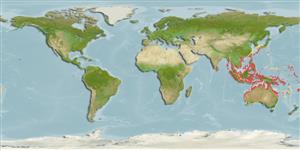>
Gobiiformes (Gobies) >
Gobiidae (Gobies) > Gobiinae
Etymology: Acentrogobius: Greek, a = without + Greek, kentron = sting + Latin gobius = gudgeon (Ref. 45335); moloanus: Named after its type locality, Molo, Iloilo, Panay I., Philippines.
More on author: Herre.
Environment: milieu / climate zone / depth range / distribution range
Ecologie
marien; brak water demersaal. Tropical
Western Pacific: Ryukyu Islands, Philippines, Indonesia (Ref. 559) and Papua New Guinea (Ref. 6771). Occurs in the Mekong delta and probably ascends to the upper edge of the tidal zone in Cambodia (Ref. 12693).
Grootte / Gewicht / Leeftijd
Maturity: Lm ? range ? - ? cm
Max length : 8.2 cm TL mannelijk / geslacht onbekend; (Ref. 125282); max. gepubliceerd gewicht: 5.90 g (Ref. 125282)
Occurs along tidal rivers and along coastlines. Feeds on small fishes and invertebrates (Ref. 12693).
Levenscyclus en paargedrag
Maturiteit | Voortplanting | Paaien | Eieren | Fecunditeit | Larven
Rainboth, W.J., 1996. Fishes of the Cambodian Mekong. FAO species identification field guide for fishery purposes. FAO, Rome, 265 p. (Ref. 12693)
Status op de Rode Lijst van het IUCN (Ref. 130435: Version 2024-1)
Gevaar voor de mens
Harmless
Gebruik door de mens
Tools
Speciale rapporten
Download XML
Internetbronnen
Estimates based on models
Preferred temperature (Ref.
123201): 24.9 - 29.3, mean 28.6 °C (based on 2118 cells).
Fylogenetische diversiteitsindex (Ref.
82804): PD
50 = 0.5000 [Uniqueness, from 0.5 = low to 2.0 = high].
Bayesian length-weight: a=0.00692 (0.00361 - 0.01325), b=3.12 (2.96 - 3.28), in cm total length, based on LWR estimates for this species & Genus-body shape (Ref.
93245).
Trofisch niveau (Ref.
69278): 4.2 ±0.73 se; based on food items.
Weerstandsvermogen (Ref.
120179): Hoog, minimale populatieverdubbelingstijd minder dan 15 maanden (Preliminary K or Fecundity.).
Fishing Vulnerability (Ref.
59153): Low vulnerability (10 of 100).
